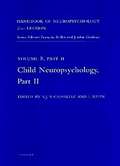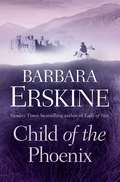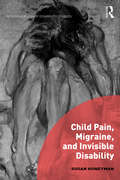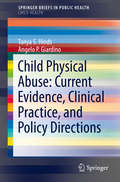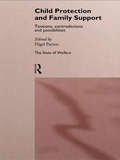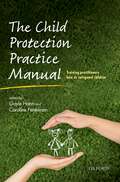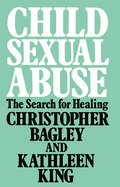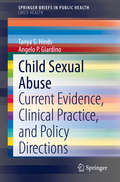- Table View
- List View
Child Maltreatment Research, Policy, and Practice: Contributions of Penelope K. Trickett (SpringerBriefs in Psychology)
by Sonya NegriffThe brief provides an overview of Dr. Penelope K. Trickett’s work and explores her innovations in the areas of theory, measurement, and methodology in the study of child maltreatment. It offers a summary of Dr. Trickett’s seminal longitudinal studies on child maltreatment, including their influence on understanding the impact of sexual abuse and child maltreatment on female and adolescent development. Chapters examine the impact of her work on policy and practice and offer present four new empirical studies that have been directly influenced by Dr. Trickett’s contributions. The brief concludes with further research recommendations to bridge the current policy and practice gaps. Topics featured in this brief include:Childhood sexual abuse and its effect on eating disorder development in females.The traumatic nature of reporting maltreatment in adolescents.Associations between adolescents’ community violence exposure (CVE) and the development of aggressive behavior problems. Child sexual abuse experiences in Korea. Child Maltreatment Research, Policy, and Practice is a must-have resource for policy makers and related professionals, graduate students, and researchers in child and school psychology, family studies, public health, social work, law/criminal justice, and sociology.
Child Maltreatment Risk Assessments: An Evaluation Guide
by Sue Righthand Bruce B Kerr Kerry DrachConduct targeted and focused evaluations of child abuse and neglect! Child Maltreatment Risk Assessments: An Evaluation Guide is a professional practice manual designed to assist clinicians in conducting forensic risk assessment in child maltreatment cases. The authors-each with an extensive background in forensic child abuse evaluation-present up-to-date research findings and provide practical, fact-based information on key issues. The book is an essential reference source on procedural issues, treatment options, and risk management strategies necessary to make high-quality, ethical evaluations. Child maltreatment risk assessments are complex, specialized evaluations with the potential for permanent legal termination of all parent-child contact on one hand, and the possibility of injury and even death on the other. Because of the weighty nature of these issues, the legal standards imposed on individual states to justify intervention is great, and evaluators must be well versed in the most current material available. Child Maltreatment Risk Assessments provides up-to-date information on the effects of maltreatment, empirically based risk factors for child abuse and neglect, specialized assessment techniques and interventions,and professional practice issues. The book emphasizes the importance of individual and cultural differences. Child Maltreatment Risk Assessments also includes a step-by-step guide to conducting and writing quality evaluations, including: components of an evaluation report forensic versus clinical evaluations methods of assessment assessment domains and much more! Child Maltreatment Risk Assessments: An Evaluation Guide is an invaluable tool for clinicians, lawyers and judges, human service agency personnel, and others involved in child maltreatment cases as well as students who represent the next generation of clinicians working in child abuse prevention and treatment.
Child Maltreatment Risk Assessments: An Evaluation Guide
by Sue Righthand Bruce B Kerr Kerry DrachConduct targeted and focused evaluations of child abuse and neglect! Child Maltreatment Risk Assessments: An Evaluation Guide is a professional practice manual designed to assist clinicians in conducting forensic risk assessment in child maltreatment cases. The authors-each with an extensive background in forensic child abuse evaluation-present up-to-date research findings and provide practical, fact-based information on key issues. The book is an essential reference source on procedural issues, treatment options, and risk management strategies necessary to make high-quality, ethical evaluations. Child maltreatment risk assessments are complex, specialized evaluations with the potential for permanent legal termination of all parent-child contact on one hand, and the possibility of injury and even death on the other. Because of the weighty nature of these issues, the legal standards imposed on individual states to justify intervention is great, and evaluators must be well versed in the most current material available. Child Maltreatment Risk Assessments provides up-to-date information on the effects of maltreatment, empirically based risk factors for child abuse and neglect, specialized assessment techniques and interventions,and professional practice issues. The book emphasizes the importance of individual and cultural differences. Child Maltreatment Risk Assessments also includes a step-by-step guide to conducting and writing quality evaluations, including: components of an evaluation report forensic versus clinical evaluations methods of assessment assessment domains and much more! Child Maltreatment Risk Assessments: An Evaluation Guide is an invaluable tool for clinicians, lawyers and judges, human service agency personnel, and others involved in child maltreatment cases as well as students who represent the next generation of clinicians working in child abuse prevention and treatment.
Child Mental Health in Primary Care
by D. PhillipsThis book helps general practitioners, health visitors and other professionals working in primary care to assess, manage and refer children and adolescents with mental health problems. School medical officers, social workers and educational psychologists, many of whom are in the front line of mental health provision for children and young people, will also find it particularly useful. Each problem is covered in a uniform way, with definitions, assessment outlines, detailed management options and indications for referral. Numerous case examples further illuminate aspects of many conditions. The book supports service provision in the new primary care environment, and forms a comprehensive practical guide to the full range of difficulties and disabilities affecting the mental health of children and young people.
Child Mental Health in Primary Care
by D. PhillipsThis book helps general practitioners, health visitors and other professionals working in primary care to assess, manage and refer children and adolescents with mental health problems. School medical officers, social workers and educational psychologists, many of whom are in the front line of mental health provision for children and young people, will also find it particularly useful. Each problem is covered in a uniform way, with definitions, assessment outlines, detailed management options and indications for referral. Numerous case examples further illuminate aspects of many conditions. The book supports service provision in the new primary care environment, and forms a comprehensive practical guide to the full range of difficulties and disabilities affecting the mental health of children and young people.
Child Neuropsychology: Clinical Practice
by John E. Obrzut George W. HyndChild Neuropsychology, Volume 2: Clinical Practice attempts to bridge the gap between neurodevelopmental theory and clinical practice with a pediatric population. The focus is on some of the more common neuropsychological disorders encountered in children, along with neuropsychological evaluation, intervention, and treatment. Comprised of 11 chapters, this volume begins with an overview of issues and perspectives in clinical child neuropsychology, followed by a discussion on neurodevelopmental learning disorders in children. The neuropsychological basis of psychiatric disorders in children are then examined, together with epilepsy and closed-head injury as well as different approaches and issues relevant to neuropsychological evaluation of children. Subsequent chapters deal with the importance of soft signs and neuropsychological screening; neuropsychological assessment of children; actuarial and clinical assessment practices; and intervention and treatment. The book also presents an overview of how one might conceptualize and integrate differential diagnosis of neurodevelopmental learning disabilities with appropriate curriculum-based intervention strategies. The final chapter considers the broader applications of behavioral neuropsychology. This book is relevant to clinical child or pediatric neuropsychologists, child or school psychologists, physicians interested in pediatric neuropsychological disorders, and other professionals who provide services to children with neurologically based disorders. It may also serve as a reference for audiologists, speech and language therapists, or educators.
Child Neuropsychology (Handbook Of Neuropsychology Ser. #8 (PDF))
by S. J. SegalowitzVolume 8 consists of Parts I and II. Part I considers theoretical perspectives in bridging developmental neuroscience with child psychology, with the role of neuroscience furthering our understanding of the child?s mental development, and a separate chapter outlines the importance of plasticity in this growth. Chapters also cover methodological issues arising from epidemiological perspectives and from psychometric concepts and issues. Methods for measuring biological brain function and structure and their particular application to child neuropsychological disorders are covered next, including ERP, PET, SPECT, MRI and fMRI technologies. Included is a chapter devoted to childhood seizure disorders. Separate chapters follow on neuropsychological assessment in infancy, in the preschool child, and in school-aged children. Following this are presentations on the development of motor control, including handedness, and somatosensory perception. Part II begins with chapters on visual development and on development in visually impaired children, followed by chapters on cognitive development in deaf children and on central auditory functions and their evaluation. This is followed by chapters on early language development and its neural correlates, developmental language disorders, and on acquired aphasia in childhood. Two chapters on dyslexia and another on dyscalculia follow. Next is a chapter on disorders of memory with a special focus on temporal lobe disease and autism, one on attention disorders, and one on executive functions in normal and abnormal development. Following this are chapters on the development of emotional regulation and on mechanisms and influences on addiction in children and adolescents. Final chapters include one on eating disorders, and another focussing on autism spectrum disorders.
Child Nutrition in South East Asia: Yogyakarta, 4–6 April 1989 (Nutricia Symposia)
by H. K. A. Visser and J. G. BindelsEighth Nutricia-Cow and Gate Symposium
Child of the Phoenix
by Barbara ErskineBeautiful repackage of this Barbara Erskine classic, the story of a remarkable mediaeval noblewoman whose life shaped the history of three crowns
Child Pain, Migraine, and Invisible Disability (Interdisciplinary Disability Studies)
by Susan HoneymanIn the twenty-first century there is increasing global recognition of pain relief as a basic human right. However, as Susan Honeyman argues in this new take on child pain and invisible disability, such a belief has historically been driven by adult, ideological needs, whereas the needs of children in pain have traditionally been marginalised or overlooked in comparison. Examining migraines in children and the socially disabling effects that chronic pain can have, this book uses medical, political and cultural discourse to convey a sense of invisible disability in children with migraine and its subsequent oppression within educational and medical policy. The book is supported by authentic migraineurs’ experiences and first-hand interviews as well as testimonials from a range of historical, literary, and medical sources never combined in a child-centred context before. Representations of child pain and lifespan migraine within literature, art and popular culture are also pulled together in order to provide an interdisciplinary guide to those wanting to understand migraine in children and the identity politics of disability more fully. Child Pain, Migraine, and Invisible Disability will appeal to scholars in childhood studies, children’s rights, literary and visual culture, disability studies and medical humanities. It will also be of interest to anyone who has suffered from migraines or has cared for children affected by chronic pain.
Child Pain, Migraine, and Invisible Disability (Interdisciplinary Disability Studies)
by Susan HoneymanIn the twenty-first century there is increasing global recognition of pain relief as a basic human right. However, as Susan Honeyman argues in this new take on child pain and invisible disability, such a belief has historically been driven by adult, ideological needs, whereas the needs of children in pain have traditionally been marginalised or overlooked in comparison. Examining migraines in children and the socially disabling effects that chronic pain can have, this book uses medical, political and cultural discourse to convey a sense of invisible disability in children with migraine and its subsequent oppression within educational and medical policy. The book is supported by authentic migraineurs’ experiences and first-hand interviews as well as testimonials from a range of historical, literary, and medical sources never combined in a child-centred context before. Representations of child pain and lifespan migraine within literature, art and popular culture are also pulled together in order to provide an interdisciplinary guide to those wanting to understand migraine in children and the identity politics of disability more fully. Child Pain, Migraine, and Invisible Disability will appeal to scholars in childhood studies, children’s rights, literary and visual culture, disability studies and medical humanities. It will also be of interest to anyone who has suffered from migraines or has cared for children affected by chronic pain.
Child Physical Abuse: Current Evidence, Clinical Practice, and Policy Directions (SpringerBriefs in Public Health)
by Tanya S. Hinds Angelo P. GiardinoThis eye-opening monograph challenges professionals across disciplines to take a more thorough and focused approach to addressing child physical abuse at the practice and policy levels. Positing child physical abuse as a public health crisis (as opposed to a more vague “social” one), the authors use empirical findings and clinical insights to advocate for wide-scale reforms in screening, assessment, responses, treatment, and prevention. The book’s social/ecological perspective delves into root causes of physical maltreatment, analyzes the role of family and community risk and support factors, and notes forms of discomfort keeping many professionals from meeting the issue head-on. From there, chapters describe coordinated multidisciplinary efforts for intervention and prevention with the potential to avert all forms of child abuse. Included in the coverage: · Adverse childhood experiences (ACEs) · The non-verbal child: obtaining a history for caregiver(s) · Clinical perspectives on multidisciplinary collaboration Corporal punishment and risk for child physical abuse Intimate partner violence (IPV) and risk for child physical abuse Evolution of child maltreatment prevention Complementary dynamic prevention approach Child Physical Abuse sets out the scope of this ongoing crisis for a wide audience including healthcare providers, child advocates, clinical social workers, public health officials, mental health providers, legislative staff professionals, and members of the lay public, with clear guidelines for effective long-term solutions.
Child Protection and Family Support: Tensions, Contradictions and Possibilities (The\state Of Welfare Ser.)
by Nigel PartonFirst published in 1997. Routledge is an imprint of Taylor & Francis, an informa company.
Child Protection and Family Support: Tensions, Contradictions and Possibilities
by Nigel PartonFirst published in 1997. Routledge is an imprint of Taylor & Francis, an informa company.
The Child Protection Handbook E-Book
by Rachael Clawson Lisa Warwick Rachel FysonThe Child Protection Handbook explains how to recognise abuse and protect at-risk children for those working with children and young people aged under 18, including in social care, education, health services, and sport and leisure settings. The book has been fully updated to incorporate the impact of new technology as well as current legal and policy frameworks that govern statutory child protection intervention in the UK. It considers all aspects of child protection, including organisational issues, children’s rights, the needs of those from diverse backgrounds, and the impacts of the Covid-19 pandemic on child protection work. With accessible, up-to-date information presented in an easy-to-navigate format, the Handbook is ideal for all busy practitioners wanting to improve outcomes for children, young people and their families. Fully updated since the last edition in 2007 – perfect for all those working with children and young people Easy to navigate and locate information – suitable as a reference book for busy practitioners Illustrative boxes in each chapter, drawing on practice case examples to highlight current issues and dilemmas All concepts explained in straightforward, jargon-free language Reflective points to encourage the reader to think about their own practice and apply new knowledge Key questions for students and teachers to check understanding and to explore concepts further Links to resources and further reading Supporting social workers in child protection practice Poverty and child protection New forms of child abuse, including technology assisted child sexual abuse, child sexual exploitation, gangs and criminal exploitation, radicalisation, forced marriage of children and young people, female genital mutilation, and faith-based abuse Focus on teenagers, including child protection in adolescence, leaving care, safeguarding and children in conflict with the law, children and young people who have displayed harmful sexual behaviour, and child to parent violence and abuse Safeguarding in sport and leisure Working with parents at risk of repeat removal of their children through care proceedings
The Child Protection Practice Manual: Training practitioners how to safeguard children
by Gayle Hann and Caroline FertlemanAround 85 children die each year in the UK due to abuse or neglect. A number of these deaths are later deemed preventable because the child involved was known to either social services or to a health professional. Cases such as those of Baby P and Victoria Climbie highlighted the failings of these organisations, ones set up to safeguard children. It is the responsibility of every health professional worldwide to identify and respond to child abuse and yet that very responsibility is both emotionally and strategically challenging. The Child Protection Practice Manual: Training practitioners how to safeguard children equips professionals with the ability to recognise a child at risk and the knowledge of how to work with a child already suffering abuse. Practical advice is offered on how to navigate the multi-disciplinary processes. Fictional case studies and exercises immerse the reader in scenarios. Building on this, the authors lead readers through learning points, recommendations, and legislation. With new definitions in child protection ranging from child sexual exploitation, gang violence, radicalisation and internet bullying through to female genital mutilation, witchcraft and spirit possession, honour based violence and forced marriage, this book will be a valuable resource for qualified paediatricians and those in training, as well as professionals who have contact with children such as GPs, nurses, health visitors, social workers, midwives, teachers, lawyers, and community workers.
The Child Protection Practice Manual: Training practitioners how to safeguard children
Around 85 children die each year in the UK due to abuse or neglect. A number of these deaths are later deemed preventable because the child involved was known to either social services or to a health professional. Cases such as those of Baby P and Victoria Climbie highlighted the failings of these organisations, ones set up to safeguard children. It is the responsibility of every health professional worldwide to identify and respond to child abuse and yet that very responsibility is both emotionally and strategically challenging. The Child Protection Practice Manual: Training practitioners how to safeguard children equips professionals with the ability to recognise a child at risk and the knowledge of how to work with a child already suffering abuse. Practical advice is offered on how to navigate the multi-disciplinary processes. Fictional case studies and exercises immerse the reader in scenarios. Building on this, the authors lead readers through learning points, recommendations, and legislation. With new definitions in child protection ranging from child sexual exploitation, gang violence, radicalisation and internet bullying through to female genital mutilation, witchcraft and spirit possession, honour based violence and forced marriage, this book will be a valuable resource for qualified paediatricians and those in training, as well as professionals who have contact with children such as GPs, nurses, health visitors, social workers, midwives, teachers, lawyers, and community workers.
Child Psychology and Psychiatry: Frameworks for Practice
by David Skuse Helen Bruce Linda Dowdney David MrazekWritten by leading clinicians and research experts in the fields of child development and psychopathology, this book is an authoritative and up to date guide for psychologists, psychiatrists, paediatricians and other professionals working with vulnerable children. The opening chapters outline neurobiological, genetic, familial and cultural influences upon child development, especially those fostering children's resilience and emotional wellbeing. Discussion of the acquisition of social and emotional developmental competencies leads on to reviews of child psychopathology, clinical diagnoses, assessment and intervention. Developed with busy professionals and trainees in mind, it is comprehensively yet concisely written, using visual aids to help the reader absorb information rapidly and easily. This book is an essential purchase for those working or training in all clinical and community child settings.
Child Psychology and Psychiatry: Frameworks for Practice
by David Skuse Helen Bruce Linda Dowdney David MrazekWritten by leading clinicians and research experts in the fields of child development and psychopathology, this book is an authoritative and up to date guide for psychologists, psychiatrists, paediatricians and other professionals working with vulnerable children. The opening chapters outline neurobiological, genetic, familial and cultural influences upon child development, especially those fostering children's resilience and emotional wellbeing. Discussion of the acquisition of social and emotional developmental competencies leads on to reviews of child psychopathology, clinical diagnoses, assessment and intervention. Developed with busy professionals and trainees in mind, it is comprehensively yet concisely written, using visual aids to help the reader absorb information rapidly and easily. This book is an essential purchase for those working or training in all clinical and community child settings.
Child Refugee and Migrant Health: A Manual for Health Professionals
by Christian Harkensee Karen Olness B. Emily EsmailiThis is a practical book for any health professional working with refugee children and families in various settings, from the initial humanitarian crisis, through displacement, living in camps, transfer between countries, settling in host countries, to return to the country of origin. Providing a holistic and intergenerational perspective, topics include the psychological impact, growth and nutrition, the management of chronic illness and infectious diseases, as well as the health of girls, pregnant women and mothers. Finally social issues such as education and the development of a healthy future generation are addressed.Child Refugee and Migrant Health is a hands-on resource for anyone who cares for children, assessing and addressing their health and psychological needs, in the best way possible, with the available resources, in any setting. There is a strong focus not just on caring for refugee and migrant children in crisis situations, but also on their families, long term physical and mental health.
Child Sexual Abuse: The Search for Healing
by Christopher Bagley Kathleen KingA comprehensive overview of the causes, treatment and prevention of child sexual abuse which approaches the problem from the perspectives of the victims, their families and the offenders themselves.
Child Sexual Abuse: The Search for Healing
by Christopher Bagley Kathleen KingA comprehensive overview of the causes, treatment and prevention of child sexual abuse which approaches the problem from the perspectives of the victims, their families and the offenders themselves.
Child Sexual Abuse: Current Evidence, Clinical Practice, and Policy Directions (SpringerBriefs in Public Health)
by Tanya S. Hinds Angelo P. GiardinoThis brief approaches the challenging topic of child sexual abuse from an objective, evidence-based perspective. It offers an overview of child sexual abuse, including definitions and a clear explanation of the epidemiology. The text also explores the conceptual frameworks that seek to explain how a child comes to be sexually abused by an adult or older adolescent. In the chapters, the authors present credible prevalence and incidence studies that are used to provide a scientific response to how common this problem is. In addition, they address the policy implications for a myriad of prevention and treatment initiatives as well as related issues such as delayed reporting and the risk for sexual abuse within child serving organizations. Finally, the brief concludes with the authors' recommendations for the future on how best to prevent child sexual abuse in the first place. Prevention of child sexual abuse is very different than prevention of child physical abuse and neglect and requires a different framework and set of initiatives. Child Sexual Abuse: Current Evidence, Clinical Practice, and Policy Directions is a must-have resource for a range of professionals including healthcare providers, child advocates, clinical social workers, public health officials, mental health providers, and legislative staff professionals. It also is written in a readable manner for members of the lay public.
Child Sexual Abuse: Informing Practice from Research
by David Jones Paul RamchandaniChild sexual abuse is widespread and often an element of many other social difficulties. This book outlines a number of different ways professionals can help, particularly focusing on the role of social workers and mental health professionals. It describes how professional intervention can improve the outcome for sexually abused children and their families. It is based on extensive evidence-based research and includes summaries of the implications for practice. Funded by a grant from the Department of Health and reviewed by an expert advisory group, this book covers the child protection process and psychological treatments in a clear and accessible format.
Child Sexual Abuse: Informing Practice from Research
by David Jones Paul RamchandaniChild sexual abuse is widespread and often an element of many other social difficulties. This book outlines a number of different ways professionals can help, particularly focusing on the role of social workers and mental health professionals. It describes how professional intervention can improve the outcome for sexually abused children and their families. It is based on extensive evidence-based research and includes summaries of the implications for practice. Funded by a grant from the Department of Health and reviewed by an expert advisory group, this book covers the child protection process and psychological treatments in a clear and accessible format.




